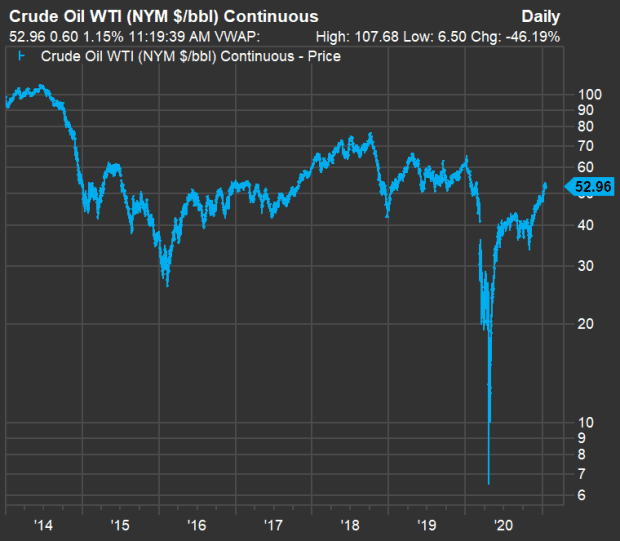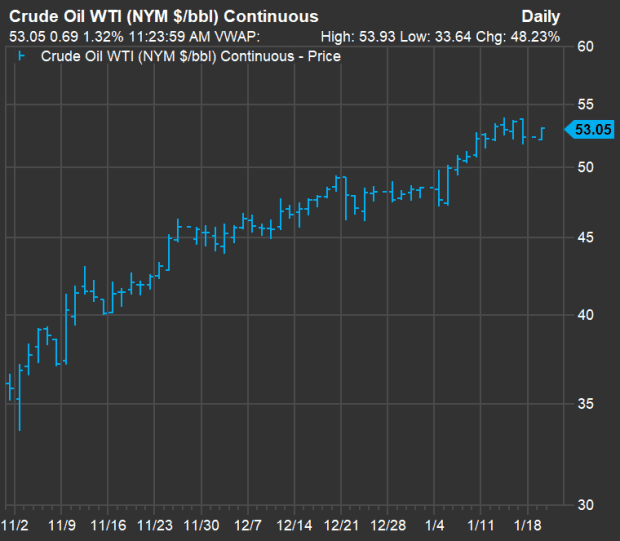Here are Wall Street’s favorite oil stocks for a 2021 recovery
Are you looking for a contrarian stock play? Try big energy — fossil fuels, to be specific.
A combination of supply cuts and demand increases has helped crude oil prices soar over the past 2½ months. Meanwhile, redlining by banks — more on that later — points to what may turn out to be a special advantage for the largest industry players.
First, let’s review what has been going on with the commodity. Here’s a chart showing the movement of continuous forward-month futures contracts for West Texas crude oil (WTI) since the end of 2013:

Here’s the action since the end of October:

That’s a 51% jump in 2½ months.
Investors have believed in the rally. Here’s how the 11 sectors of the S&P 500 Index SPX,
Covid-19 vaccines give hope that the world can return to a normal economic growth path, maybe later in 2021. However, the winter spike in coronavirus cases has led the International Energy Agency to cut its demand forecast for 2021. Then again, the IEA report was published Tuesday, and WTI for February delivery CLG21,
Sure, it is easy to give up on oil. The short-term path for oil and natural gas stocks may be rocky from here — until the pandemic appears to be ending. And for the very long term, the increased use of electric vehicles doesn’t bode well for gasoline demand.
But all the electricity needed for the new electric fleet has to come from somewhere, including power plants that make use of fossil fuels. Oil and natural gas producers will continue to fuel heavy vehicles, aircraft and ships.
A new form of redlining
Redlining, the old practice of some banks to avoid lending to entire regions, is illegal. But in the world of ESG investing — that stands for environmental, social and governance — companies are trying to make sure investors believe they are doing everything they can to avoid supporting activity that harms the environment, while also improving society in various ways.
This has led many large U.S. banks, including Morgan Stanley MS,
The Biden administration may try to reverse President Trump’s decision to open up drilling in ANWR. But that doesn’t mean the big banks won’t curtail their lending to oil companies drilling in other areas.
In his daily energy report on Jan. 15, Phil Flynn, a senior market analyst at Price Futures Group, wrote that smaller shale-oil producers would bear the brunt of banks’ reluctance to lend to the industry.
“In other words, the much derided ‘Big Oil’ companies will become bigger and stronger while smaller independents will crack under the weight of more regulations and the inability to secure capital,” he wrote.
Wall Street’s favorite oil stocks
So what does all this to mean to investors? You have the commodities — oil and natural gas — that have come under tremendous pressure. The price of crude oil is less than half of what it was not so long ago. Meanwhile, U.S. shale producers faced long odds against breaking even last year. Looking ahead, the OPEC nations and Russia are motivated to keep pushing prices higher by managing supply.
When the pandemic finally ends, a euphoric reaction in the market could send oil soaring even from current levels. Sustained economic growth could also support significantly higher prices.
Looking at the S&P 500, there are 25 energy stocks. Here are all of them, ranked by the percentage of “buy” or equivalent ratings among Wall Street analysts. The table includes consensus price targets.
The table has a lot of data — you will need to scroll to see it.
In addition to the ratings information, there are 12-month price targets. Some of the targets aren’t much higher than the current share prices, even for the companies with the most “buy” or equivalent ratings. One year may not be long enough for a price target for a long-term investor, especially when looking at a commodity-recovery play dependent, in part, on the end of the pandemic.
Dividend yields are included in the table. Shares of Exxon Mobil Corp. XOM,




